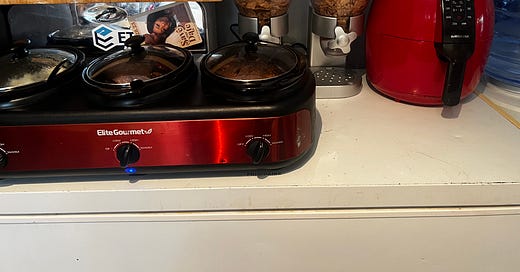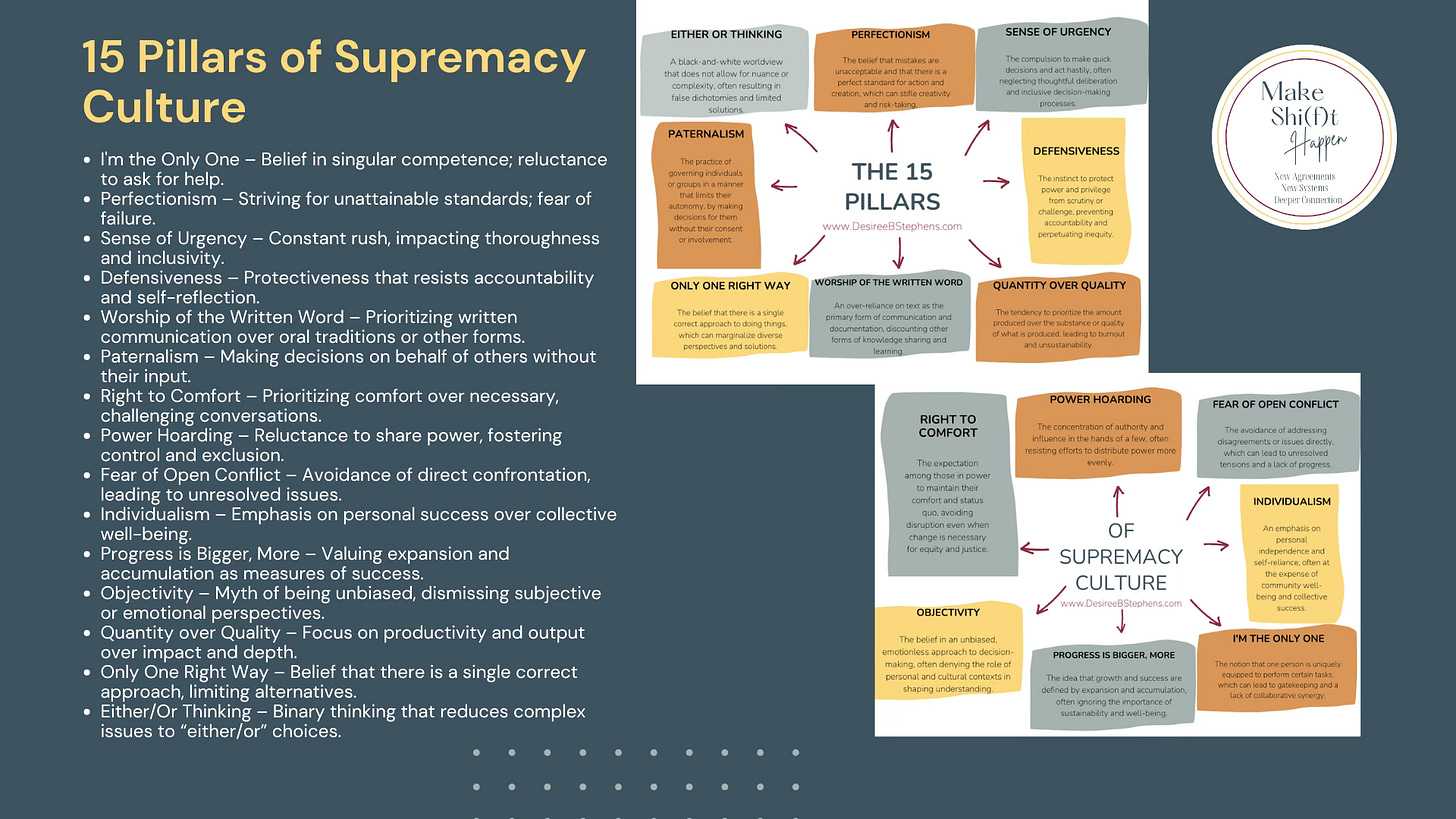Neuroaffirming Home: Designed to Meet the Needs of Everyone
Neuroaffirming Systems for Everyday Life
This morning, I found myself standing in our kitchen, setting up what looks like a simple food station. A stool placed carefully for Shady Baby, a three-part crock pot filled with farina, BBQ meatballs, and sweet potatoes—warm, nourishing options that will be available all day. Bacon crisped to perfection in the air fryer, and clear storage bins stocked with cereal, utensils, bowls, and cups—all visible, labeled, accessible.
This is not a Pinterest moment. It’s a liberatory one.
Because this wasn’t about aesthetics or convenience. It was about designing a space that meets the real, neuroDIVERSE (not divergent) needs of my family, a family made up of many different brains, processing styles, sensory needs, and support levels. I'm old-school Ritalin ADHD. Erin is AuDHD with high ADHD support needs and medium autism support needs. Kieran is AuDHD with medium support needs for autism, very high support needs for ADHD. Morrigan…"Shady Baby", is ADHD and dyslexic with low support needs, and high sensory needs.
And when you build a home around the people in it instead of trying to force the people to conform to the space, you make liberation tangible.
Neuroaffirming vs. Accommodation
There’s a big difference between a home/school/workplace that is accommodation-based and one that is neuroaffirming. Accommodations are often reactive: a response to a child melting down, forgetting, or struggling. It starts from a framework that says:
“Here’s the norm, and here’s an exception we’ll make for you.”
Neuroaffirming design is proactive. It doesn’t center the “norm.” It assumes and anticipates a range of needs from the start. It doesn’t ask: “What do we do when someone fails to conform?”
It asks: “How can we make sure no one has to mask or break themselves to belong?”
And when we do that? Everyone benefits.
Erin doesn’t have to ask for help locating food. Kieran doesn't have to navigate unclear kitchen zones or overstimulating transitions. Shady Baby can serve herself and feel the pride of autonomy. I don’t have to spend all day managing everyone’s needs, because the systems we built manage themselves.
Why This is Liberation Work
When we design in ways that center the most impacted, the most overwhelmed, the most sensory-sensitive, the most dysregulated, we're not isolating them. We're creating systems that work better for everyone.
Supremacy culture survives by pretending that there is only one right way to be. It values control, compliance, invisibility, and perfection. Neuroaffirming spaces resist that at every level.
Here are just a few of the 15 pillars of supremacy culture that are actively being dismantled through the design of our home:
1. “Only One Right Way”
Our systems say: There are multiple valid ways to function.
There is no single correct way to eat, sleep, learn, or regulate. Whether it’s stimming in a compression corner, skipping traditional mealtime rules, or using bins instead of drawers, the “right” way is the way that works for the person using it.
2. Paternalism
Traditional design often assumes adults know best, and children must adapt. Our home says:
Even the youngest member deserves autonomy.
We offer access without asking. We build trust by removing gatekeeping. And we listen to what our kids' behaviors and bodies are trying to tell us, not just our own rules.
3. Either/Or Thinking
Supremacy culture forces binaries: organized or messy, functioning or not, smart or struggling. But neurodivergent life is nuanced. In our home, structure and freedom coexist. Support and independence are both valid. Joy and mess can live side by side.
4. Perfectionism
Neuroaffirming design says: Done is better than perfect.
We don’t wait to get it “right”—we iterate in real time. Our goal isn’t aesthetics. It’s regulation, autonomy, and sustainability. And that means making space for mistakes, restarts, and reworks without shame.
5. Worship of the Written Word
Not everything has to be verbalized, documented, or memorized. We use visual cues, clear labels, tactile systems, and physical rhythms to communicate.
We externalize what neurotypical culture expects people to internalize.
That’s not a workaround, it’s a revolution in how we communicate care.
The Real Cost of ADHD
Let’s talk about the economics of this. ADHD, and executive dysfunction in general, comes with a very real cost. The average neurotypical home might have a basic kitchen setup. A neurodivergent home needs:
Visual storage systems
Task-specific zones
Time-saving appliances
Extra backups of daily-use items
Snacks and meals that don't require complex prep
These aren’t luxuries, they’re access tools. And yet, because they aren't covered by insurance or considered "medical accommodations," families often bear the full cost of simply making the home functional.
But I’ll say this: it costs less to support than it does to repair.
As per the request of
here is where you can find all of my home creature comforts that makes life easier for us all on the S&S Healing Homestead: #AtHomeWithDezWhy I Say Neurodiversity, Not Neurodivergence
Language matters.
And in this home, we choose language that liberates.
You’ll notice I use the term neurodiverse or neurodiversity to describe our family, not “neurodivergent.”
Why?
Because divergence implies deviation.
It implies there’s a standard, a “normal”, and that some people are off course.
But normal, in the context of human brains and behavior, is a social construct.
And not just any construct, it’s one built under the gaze of white, cisgender, heteronormative, colonial, Christian patriarchy.
It’s the kind of construct that:
Labeled enslaved people with “drapetomania” for seeking freedom
Called autistic children “empty fortresses”
Still centers white boys in diagnostic criteria while Black children get suspended instead of supported
So when we say someone is divergent, we are (consciously or not) anchoring them to a false “center.”
We’re comparing them to a standard that was never neutral, and never inclusive.
Neurodiversity is the Truth
Neurodiversity, on the other hand, names what has always been true:
That there are many ways of thinking, sensing, learning, and being.
That variation is natural.
That human brains were never meant to be identical.
When I say my family is neurodiverse, I’m not saying anyone is wrong.
I’m saying we are many.
And every brain in this home gets to be right.
This framing removes the burden of “adjustment” from the person and places the responsibility on the system.
Because it’s not our children that need to conform.
It’s our systems that need to expand.
Language as Liberation
Words shape worldview.
And when we shift from “divergence” to “diversity,” we reclaim the right to exist outside of comparison.
We affirm that there was never just one way to be, and there never will be.
This is why I say neurodiverse.
Because no one in my home is broken.
Because sameness was never the goal.
Practice Your Praxis: Self, Home & Work Integration
SELF: Liberation starts with how you treat your own body and brain.
Ask: What do I need to thrive today, not just survive? Write it down. Speak it aloud. Center it in your decisions.
Track your nervous system cues. Not just stress—notice calm, joy, ease. Those are survival data too.
Name your needs without apology. “I need visual cues.” “I need transition time.” “I need fewer inputs.” This is not asking for favors. This is stating facts.
Practice sensory sovereignty. Adjust light, sound, scent, touch—reclaim your sensory environment as a birthright, not a luxury.
Rest is not earned—it is essential. Lay down. Log off. Not to be better later. But because rest is part of liberation now.
HOME: Build the village your nervous system can live inside.
Design for now, not someday. Set your home up for today’s energy level and reality—not an aspirational version of yourself.
Create systems that don’t rely on memory. Visual charts, labeled bins, automation tools—support your brain instead of shaming it.
Normalize access. Everyone should be able to feed themselves, find comfort, and seek quiet without surveillance or struggle.
Make rest visible and valid. Cozy corners, weighted blankets, “off” hours—signal that downtime is part of the family rhythm.
Rebuild tradition. If a practice isn’t working (folding clothes, forced family dinners, noise-heavy mornings), let it go. Create rituals that affirm how you live.
WORK: Decolonize productivity. Reimagine professionalism. Honor your rhythms.
Challenge urgency culture. Just because it’s labeled “urgent” doesn’t mean it’s aligned.
Ask: Is this urgent, or is it expected?
Design sensory-safe workspaces. Use noise-canceling tools, natural lighting, flexible seating, or lighting changes to ground your workflow.
Make access non-negotiable. Integrate calendar buffers, asynchronous options, body breaks, and visual agendas into team rhythms.
Question performance metrics. Who do they benefit? Who do they erase? Shift from output to impact, from quantity to sustainability.
Be transparent with boundaries. Normalize saying: “I work best with visuals.” “I’m not available for multitasking.” “This pace is not sustainable.”
Dismantle professionalism as white respectability. Your cultural rhythms, ways of speaking, or emotional expressiveness are not liabilities. They’re wisdom.
Final Reflection
This was never about building a perfect home.
It’s about building a life where no one has to shrink to fit inside it.
We deserve rest without guilt.
We deserve rhythm without rigidity.
We deserve systems that honor our brilliance, not just contain our chaos.
Because when we design for the most impacted,
we don’t just include them, we transform the space for everyone.
This isn’t about catching up to neurotypical norms.
It’s about breaking up with them entirely.
We’re not replicating the systems that harmed us.
We’re remembering how to build something better.
When your home affirms your body and brain,
when your workplace respects your pace and presence,
when your self-talk becomes a sanctuary instead of a battleground—
you no longer have to recover from the places you live, work, or rest.
You get to be whole.
You get to be held.
And so does everyone else.
This is care.
This is access.
This is the sacred work of liberation, made tangible, one room at a time.
When you are in a space ask yourself… Hows That Working For You?
In solidarity and liberation,
Desireé B. Stephens, CPS-P
Educator | Counselor | Community Builder
Founder, Make Shi(f)t Happen
New Agreements, New Systems, Deeper Connections
Writer of Liberation Education
Where Reflection Meets Transformation






The way I needed to hear this today. We just received Max’s diagnosis (AudHD) and I have been struggling to put into words WHY the way we do things for our kids is so essential. It’s not just sticking to systems or routines, it’s providing them what they need first and the best chance at feeling safe and regulated each day. I’m
Not rigid about things because I’m a control freak- my brain just feels so overwhelmed when I don’t allow my ADHD to be accommodated first.
this really hit home and felt validating ❤️
As usual you are saying so so many things I deeply needed to hear. I want to make a space where I can thrive, not just be useful to capitalism.